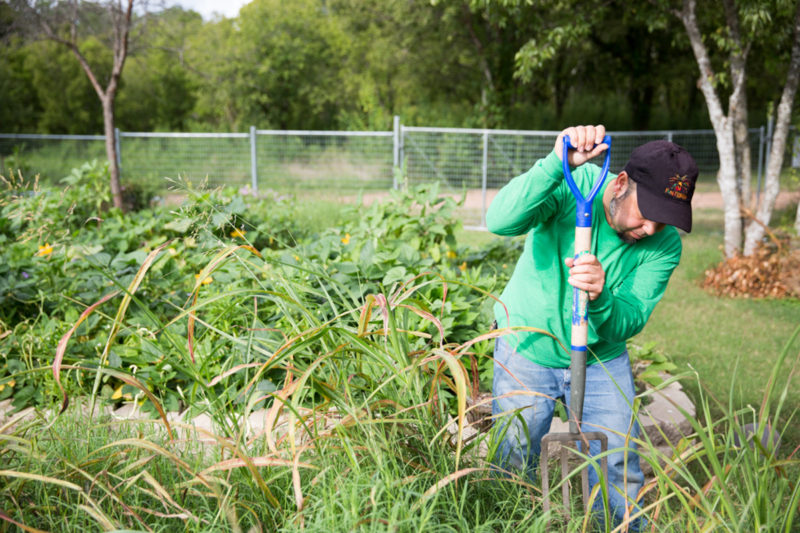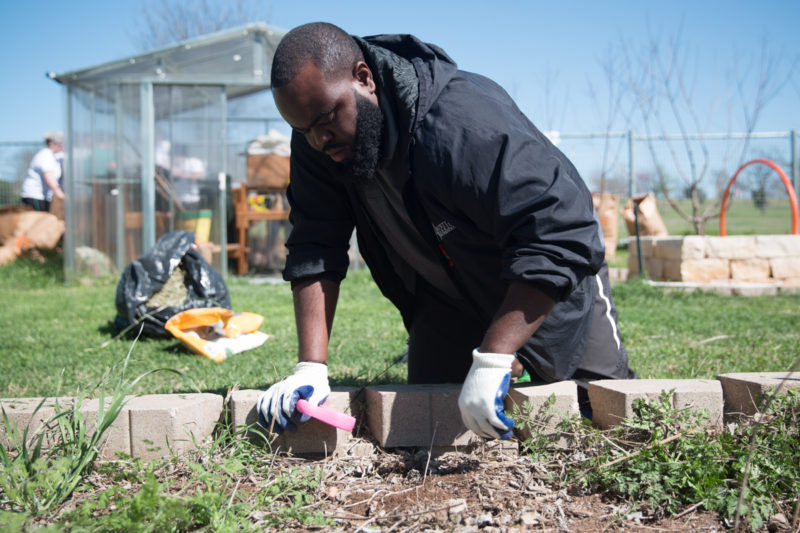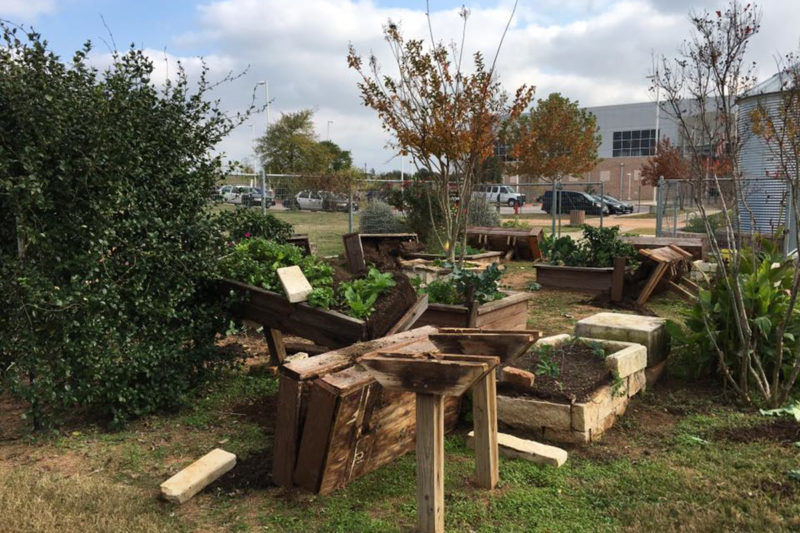Rundberg Neighbors Rally to Restore Vandalized Community Garden
By Shelby Knowles
Photography By Shelby Knowles
Reporting Texas

Former garden manager Joseph de Leon tends to the plots before a recent Saturday morning work day. The community garden has become a place for residents to grow vegetables and interact with their neighbors. Shelby Knowles/Reporting Texas
Joseph de Leon was grocery shopping on a mid-December Saturday morning when he received an urgent text message: the community garden at the Gus Garcia Recreation Center on Rundberg Lane had been vandalized and partially destroyed.
Within minutes, de Leon was at the garden, a few blocks east of Interstate 35, where he had been the manager.
“I was shocked,” he said. “I saw the senior beds tipped over from the parking lot. The more I looked around, the worse I felt.”
Vandals had uprooted the raised beds and toppled the wood frames. They had spray-painted profanities on the tool shed, greenhouse and rainwater tank. Most of the damage affected the senior citizen beds near the front of the garden.
“I couldn’t believe someone would do this,” said de Leon, shaking his head in disbelief.
Since the garden opened in 2012, it has become a gathering spot for residents who rent one of the 30 beds and pay $50 a year to plant vegetables while interacting with neighbors. There’s a small orchard and a greenhouse — an oasis in an area with plenty of challenges. Thirty percent of residents live below the poverty line, and 64 percent speak a language other than English, according to Census data.
The population is more than 60 percent Hispanic, and it includes immigrants and some refugees from the Middle East, Asia, Africa and Central America. There are homeless camps, including one not far from the garden.

Delano Brown, Gus Garcia site supervisor, clears weeds from a garden, part of the effort to restore and clean up the vandalized garden. Shelby Knowles/Reporting Texas
The 6-square-mile area stretches north of Research Boulevard, between Lamar on the west and I-35 and Cameron Road on the east. Rundberg Lane runs roughly through its middle.
The area has 5 percent of the city’s population but accounts for 7 percent of property crimes and 9 percent of crimes such as criminal mischief and prostitution.
Crime has dropped considerably thanks to an intensified community policing initiative. Restore Rundberg, as the project is known, used a three-year federal grant to put more officers walking the streets, talking to residents and working with social services to reduce crime.
But the grant ended in October. Now, the community has to rely on itself to overcome challenges, said Rafael “Ray” Kianes, an Austin police officer who helped lead the Restore Rundberg initiative.
“Anomalies are going to happen. It doesn’t matter if it’s an affluent community or poor community, there is no place that will have zero crime,” Kianes said. “But it’s how the community responds to a crime that’s important.”
Kianes said the vigorous community response to the vandalism – the reconstruction started right away – was evidence of its resilience, and of the garden’s importance.
The garden was an addition to the Gustavo “Gus” L. Garcia Recreation Center, named for a former Austin mayor, which opened in 2008 to provide a welcoming beacon that the neighborhood had lacked.
Initially, the garden struggled to create community interest, de Leon said.
“The first two years were really frustrating, because there was very little participation in the garden. We were sure that people would flock to the garden, but that didn’t happen,” he said.
Slowly, the community’s interest grew into a thriving garden with plots full of vegetables.
One frequent gardener is Kee Yom, a refugee from Myanmar who resettled in Austin with his family two years ago. Yom said his family uses its bed to grow okra, mint and roselle, a type of hibiscus native to his homeland.
“In Burma, we didn’t do this kind of gardening; we gardened in the mountains,” Yom said. “We slashed trees, burned it and grow food, then move to a new area — this is easier.”

The garden was vandalized the night of Dec. 16, 2016. The raised garden beds dedicated to senior citizens were toppled and destroyed. Photo courtesy of the Gardens at Gus Garcia
Since he started gardening in Austin, he’s had the opportunity to try new foods and plants not typically grown in Myanmar. Over the past two years, Yom and his brother have tended their own plots and volunteered to help other residents to develop theirs.
But the news of the vandalism was devastating; four years of hard work had been thrown to the ground.
“We’ve tried really hard to be as inclusive as possible and provide a community space that everyone can be proud of,” said De Leon, who had been garden manager since the beginning. While he recently resigned, he remains deeply invested in the garden.
Police investigated but found no suspects. Some residents speculate that the perpetrators may have been mischievous school kids on winter break. Others wonder whether the culprit came from the nearby homeless camp that police recently had cleared.
Regardless of who did it, de Leon said the garden would have welcomed them.
“I have sympathy for [the vandals] and I wish there was something the garden could do to connect with them.”
Linda Powers, a steering committee member for the gardens, quickly notified the gardeners of the incident.
The community didn’t miss a beat. Frequent gardeners came within an hour of hearing the news to offer their support, and their shovels.
People from outside the neighborhood pitched in to help. Thirty students from the University of Texas at Austin came on a chilly Saturday morning to help. They were part of The Project, an initiative in which students volunteer for a day to help a different neighborhood each year.
The senior citizen garden beds were rebuilt with a sturdier base thanks to a $3,900 donation from Resolution Gardens, an Austin landscaping company. The garden gates have new locks, and bright solar-powered lights shine at night, hopefully to deter future vandals.
By February, the cleanup was completed, and gardeners were back tending their beds.
Delano Brown, Gus Garcia Recreation Center supervisor, who was the first to discover the damage, said the vandalism was discouraging and disheartening. But, ultimately, the events led to a more compassionate, resilient community.
“Everyone working together just reinforced the collective effort of everyone in the community,” Brown said. “If the garden got destroyed and it took six to seven months to repair, then the residents would have felt forgotten. The fact it got repaired quickly proves how important the garden is to everyone.”